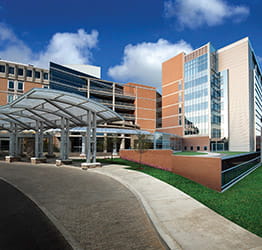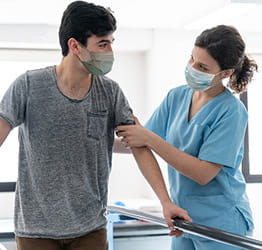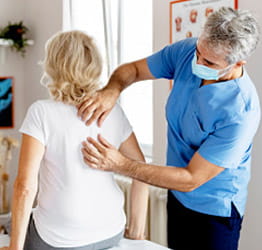What Is the UPMC ENT Sleep Division?
The UPMC Ear, Nose, and Throat (ENT) Sleep Division takes a comprehensive approach to diagnosing and treating all sleep conditions.
If you regularly have trouble sleeping or think you have sleep disorder symptoms, a sleep specialist can take a history of your symptoms, perform an evaluation, and recommend appropriate tests to make a diagnosis. Once your provider has arrived at a diagnosis, they can tailor a plan to your unique needs.
Our team of ENTs and other sleep subspecialists find the most effective treatment for your sleep condition. The goal is to help relieve the medical and personal side effects of poor-quality sleep.
Sleep conditions can be best diagnosed through self-reported symptoms, medical evaluations, and specific diagnostic tests.
Some diagnostic tools used in diagnosing a sleep disorder include:
- Home sleep apnea tests — For suspected sleep apnea, a home sleep apnea test might be suggested. This test measures breathing patterns and oxygen levels while you sleep at home. This test can be diagnostic or done as part of therapy.
- In-laboratory sleep studies — Your doctor may recommend polysomnography, a sleep study completed in a sleep laboratory. This test monitors various body functions during sleep, such as brain activity, eye movements, heart rate, and breathing patterns. It can be diagnostic or done as part of therapy.
- Sleep diary — A sleep diary can help your doctor understand your sleep patterns. Keep track in your diary daily, listing your bedtime and wake-up time, as well as whether you took a nap, exercised, or consumed alcohol or caffeine that day and at what time(s).
These methods help doctors diagnose sleep disorders to ensure you receive the appropriate treatment and management.
Back to top.
What Conditions Do You Treat?
The most commonly diagnosed condition sleep specialists treat is sleep-disordered breathing, including snoring, upper airway resistance syndrome, and obstructive sleep apnea (OSA) — a condition that causes you to stop breathing for short periods while sleeping.
Obstructive sleep apnea
OSA is characterized by repeated episodes of collapsing soft tissues in the throat, resulting in partial or complete blockage of the upper airway during sleep. These disruptions in the breathing pattern during the night can decrease oxygen delivery to body tissues, leading to various health problems.
Common symptoms of obstructive sleep apnea can include:
- Choking.
- Difficulty with memory or concentration.
- Excessive daytime sleepiness.
- Gasping.
- Insomnia.
- Irritability or mood changes.
- Morning headaches.
- Pauses in breathing.
- Snoring.
- Waking up frequently at night to use the bathroom.
However, obstructive sleep apnea often coexists with insomnia, restless legs syndrome, central hypersomnia, circadian rhythm issues, and a multitude of other sleep disorders. For that reason, a consultation with a sleep specialist can be beneficial as there may be more than one issue affecting your sleep.
Back to top.
What Treatments Do You Offer?
The UPMC ENT Sleep Division offers all available treatment options for obstructive sleep apnea and other sleep disorders. Our experts provide the latest technologies and most minimally invasive therapies in one location. We're a one-stop shop for sleep disorder care.
Medical Treatments for Obstructive Sleep Apnea
We offer a range of nonsurgical treatments for sleep disorders.
Nonsurgical treatments for sleep disorders
Behavioral changes
Lifestyle modifications can often be helpful in treating mild obstructive sleep apnea or even improving the effectiveness of conservative treatments.
Some of these modifications include:
- Avoiding alcohol.
- Avoiding sedative medications
- Stopping smoking.
- Using a topical nasal spray or other allergy treatment to relieve nighttime congestion.
- Using a wedge pillow to keep you sleeping on your side or a cervical pillow to keep your neck extended.
Ensuring that the nasal airway is open at night is a key factor in treating obstructive sleep apnea.
Bilevel positive airway pressure (BIPAP) therapy
BIPAP therapy offers two levels of pressure delivery. It uses a higher pressure when you inhale and a lower pressure when you exhale, which often can improve comfort.
Continuous positive airway pressure (CPAP) therapy
CPAP therapy consists of a nasal or face mask, tubing, and a small machine that provides positive airway pressure while you sleep. CPAP delivers room air to help keep your airway open while sleeping, thus eliminating the disruptions in your breathing pattern during the night.
Oral appliance therapy (OAT)
Oral appliances are custom-fitted devices made by sleep dentists and worn in your mouth when sleeping. These devices reposition the lower jaw and tongue to help keep the airway open when the soft tissues in the throat collapse at night.
Weight loss
Whether through diet and exercise, weight loss medications, or bariatric surgical procedures, losing weight has been consistently shown to reduce OSA severity and improve success rates with other treatments.
Surgical treatment for sleep disorders
If you haven't succeeded with more conservative measures, you may be a candidate for a surgical procedure to treat your sleep disorder.
Surgical treatments we provide for the treatment of sleep disorders include:
Hypoglossal nerve stimulator implant (Inspire)
This type of surgery uses a pacemaker-like device to activate the hypoglossal nerve – the nerve responsible for tongue movement – during sleep. The nerve stimulation device is implanted under the skin through incisions under the chin and below the collarbone. A remote control activates the system at bedtime to improve airflow by gently moving the tongue forward with each breath.
Nasal surgery
Although not typically a stand-alone treatment for OSA, alleviating nasal obstruction and improving nasal breathing can be an effective adjunct treatment. Septoplasty surgery to straighten the nasal septum and turbinate reduction to reduce the size of the tissues lining the nasal cavities can improve snoring and sleep and facilitate better results with CPAP or oral appliance therapy.
Pharyngeal surgery
In select patients, throat tissue surgery can be indicated to treat OSA. Removing enlarged tonsils or adenoids or more advanced reconstructive procedures to enlarge the breathing passage can improve sleep and breathing.
Skeletal surgery
Maxillomandibular advancement (MMA) surgery is a procedure that moves the maxilla (bones of the upper jaw) and mandible (lower jaw) forward to open the airway behind the soft palate and tongue. By moving the jaw forward, the airway space is more open and less likely to be obstructed.
Back to top.
What Can I Expect?
We provide a comprehensive sleep history and exam, an endoscopy of the nose and throat when indicated, and the latest diagnostic sleep testing. Testing can usually be performed in your home.
- When you arrive for your appointment, you may meet many members of our sleep team. This includes our front desk staff, medical assistants, physician assistants, residents, and sleep and research coordinators.
- If you’ve received any questionnaires or paperwork to complete before your office visit, please bring them to your appointment. If you did not receive paperwork in the mail, there will be paperwork to complete before you're evaluated by the sleep provider when you check in for your appointment.
- Please arrive at least 15 minutes early for your appointment to check in on our kiosks, complete any additional forms in our office, and ensure that you are ready to be called to a room as close to your appointment time as possible.
- One of our medical assistants will bring you back to the examination room. Before you see the provider, they will obtain your vital signs, review your allergies and medications, and review your health history.
Before your visit
We will provide a comprehensive sleep history and exam, an endoscopy of the nose and throat when indicated, and the latest diagnostic sleep testing, which can be performed in your home or the sleep laboratory. Our office staff will assist you with obtaining the appropriate diagnostic testing.
Your first visit
To prepare for your first visit with us, we ask you to provide:
- A detailed sleep history, including any prior sleep testing or prior records of sleep treatments.
- Health insurance information.
- Your family medical history.
During the visit, the doctor will perform a physical exam. They'll also check your throat and may perform a flexible endoscopy. This test is painless and lasts between two and three minutes.
Endoscopy includes inserting a flexible tube with a tiny camera up your nose to give the doctor a close-up look at your:
- Adenoids
- Nasal cavity
- Tongue
- Voice box
This view will help your doctor make a more thorough diagnosis of your sleep problem.
Our sleep specialists will then work with UPMC ENT experts to discuss all treatment options before considering surgical intervention for snoring and sleep apnea.
Back to top.
Why Choose UPMC for Sleep Division Services?
UPMC’s team of ENT sleep experts is led by Pittsburgh's first board-certified sleep medicine and sleep surgery physician, Ryan Soose, MD. The UPMC team of specialty-trained ENT sleep medicine physicians conducts comprehensive sleep histories and examinations. We offer the latest in diagnostic sleep testing, which can usually be completed in the comfort of your own home. After diagnosis, we offer a host of noninvasive treatments according to a unique treatment plan created specifically for you.
Back to top.
By UPMC Editorial Staff. Last reviewed on 2024-10-01.















